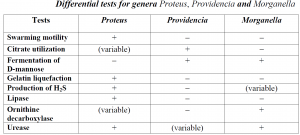Contents:
Proteus species are Gram-negative aerobic bacteria. Their scale is between 0.4 and 0.8 μm in diameter and between 1.0 and 3.0 μm in length. They are named on the basis of their capacity to undergo colonial morphological changes. Proteus strains are able to grow in temperatures ranging from 10 to 43 °C. The optimal temperature for Proteus is 25 °C. The swarming occurs between 20 and 37 °C.
History of Discovery
- The first representatives of genus Proteus (P. mirabilis, P. vulgaris) were isolated in 1885 by the German bacteriologist G. Hauser from putrefied meat.
- The name of genus, proposed by Hauser, goes back to the sea-god of Greek mythology Proteus, famous by his active body transformations. Similarly, discovered microbial culture was capable of rapid changing of its morphology and growth characteristics.

Classification
- Genus Proteus belongs to the family Enterobacteriaceae.It comprises microbial species P. vulgaris, P. mirabilis, P. myxofaciens, P. рenneri, and P. hauseri.
- Some other closely related bacteria pertain to genus Providencia (type species – P. rettgeri), and genus Morganella (species M. morganii).
Structure and Properties
- The bacteria look like straight rods 0.5-2 μm in size without spores and capsule.
- Most of microbial cells demonstrate striking motility due to the multiple peritrichous flagella.
- They easily grow on basic nutrient media at 35-37оС, pH 7.2-7.4. Motile bacteria designated as microbial H forms (from German hauch – mist or breath) render swarming growth, when cultured on solid media.
- Non-motile O-variants produce round-shaped semitransparent colonies. Microbial growth is followed by fishy odor.Culturing on Endo or McConkey agar results in lactose-negative bacterial colonies.
- Some characteristics of a Proteus culture are swarming and an ammonia smell.
- Type of respiration – facultatively anaerobic.
- The bacteria possess versatile biochemical activities. They ferment numerous carbohydrates with acid and gas end products, liquefy gelatin, produce H2S, reduce nitrates to nitrites.
- The members of Proteus genus have catalase and marked urease activity.
- Unlike other enterobacteria, they are capable of phenylalanine deamination.
Differentiation of genera Proteus, Morganella and Providencia rests on a number of tests indicated in table

Environmental resistance of Proteus species is rather high. At low temperatures they stay viable for a long time. When heated at 60oС bacteria maintain viability near to 1 h.
- Proteus is found as an opportunistic human pathogen in the gastrointestinal tract , skin, and oral mucosa of humans and animals, as well as in faeces, soil , water, and plants. Proteus enables spolage of raw meat, fish , vegetables, and canned food.
- When Proteus grows in milk, the milk curds, and then liquefies.
Virulence Factors and Characteristics of Infections
- Multiple adhesins and fimbriae actively expressed by swarming bacteria promote rapid adhesion of microbial cells to the host epithelium. They are predilected for binding to epithelium of urogenital tract and kidneys.
- Excessive urease synthesis followed by urea hydrolysis leads to accumulation of ammonia in urinary tract, consequent inflammation and formation of kidney stones or urinary stones.
- P. vulgaris, P. mirabilis and P. penneri produce hemolysins and cytolysins that damage red blood cells, leukocytes, epithelial cells, fibroblasts.
- Bacterial proteases are able to destroy host IgGs and IgAs in mucosal tissues and increase vascular permeability.
- Proteus is the constant habitant of human gastrointestinal tract. It is also found as a part of normal microflora in many animal species. It resides in soil, sewage waters, manure, putrefied organic matter and other substrates.
- Nevertheless, enterobacteriae of Proteus genus are concerned as common agents of hospital-acquired infections (just behind escherichiae and klebsiellae).
- They primarily cause urinary infections, abdominal infections, pneumonia, suppurative wound complications, infections of soft tissues. Progressive infections may result in generalized systemic disease (sepsis). Proteus mirabilis is known to be the major reason for this as other proteus species are also responsible.
- Proteus mirabilis can also cause infection in the respiratory tract, eye, ear, nose, skin, throat, burns, and wounds and has been implicated in neonatal meningoencephalitis, empyema, and osteomyelitis.
Laboratory Diagnosis
- Specimen collection depends on primary site of infection.
- Laboratory diagnosis of infection is based on isolation of bacterial culture.
- During cultivation proteus species demonstrate characteristic swarming motility. Bacteria are further distinguished according to their biochemical and other activities.
- For instance, P. vulgaris cultures produce indole, P. mirabilis ferments maltose, Voges-Proskauer test is positive in P. myxofaciens and variable in P. mirabilis; H2S test is negative in P. myxofaciens and weakly positive in P. рenneri.
- Serological typing, phage typing and molecular genetic tests (PCR) accelerate and improve microbial identification.
Treatment and Prophylaxis of Infections
- Prophylaxis of infections caused by various proteus species is non-specific.
- Treatment includes administration of third generation cephalosporins (e.g., cefotaxime), fluoroquinolones, or modern protected penicillins (amoxycillin combined with clavulanic acid). Multiple drug-resistant strains of proteus are generally less common than in klebsiellae.
References
- https://www.sciencedirect.com/topics/medicine-and-dentistry/proteus
- https://www.ncbi.nlm.nih.gov/pmc/articles/PMC4638163/
